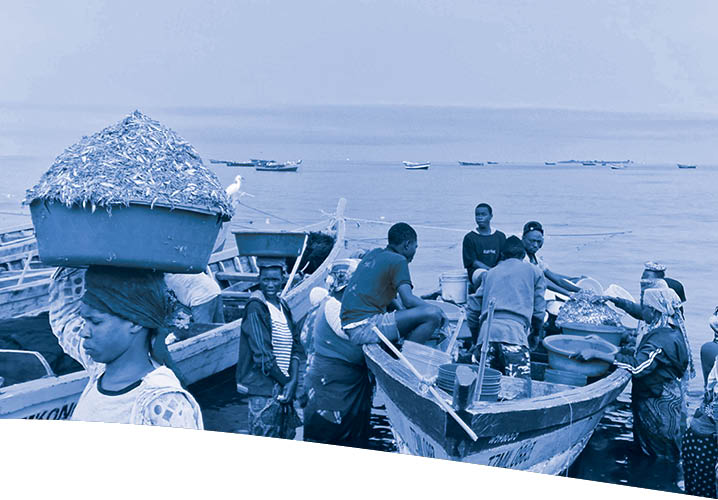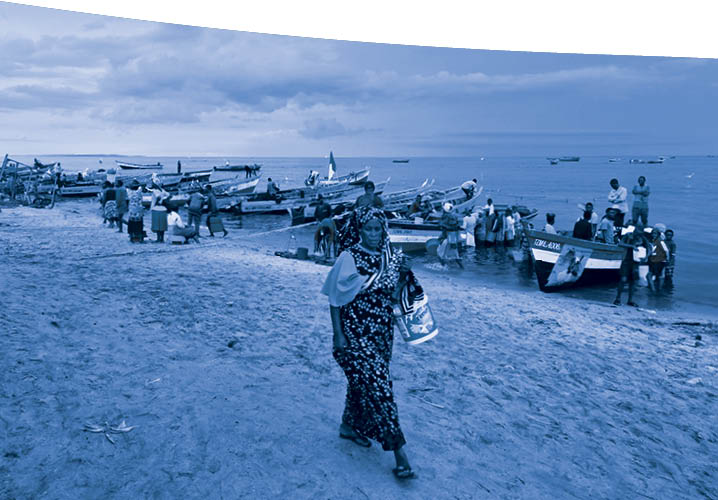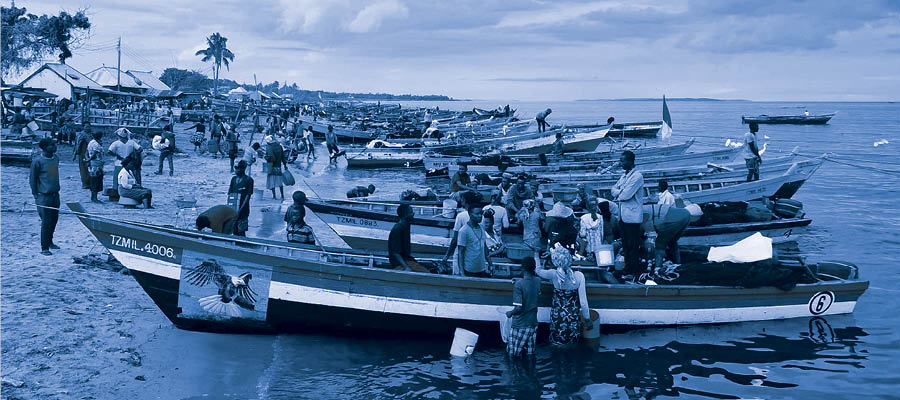Multidimensional solutions strategy for the reduction of food loss and waste in the dagaa fisheries in the United Republic of Tanzania mainland
This multidimensional solutions strategy for reducing the losses is a comprehensive, multisectoral approach aimed at addressing the challenges and maximizing the potential of the dagaa fishery industry in the United Republic of Tanzania. It strives to tackle the significant losses with a strong emphasis on promoting the responsible use of fisheries resources for sustainable development. The strategy’s design is based on the robust foundation of assessment findings, extensive engagement of stakeholders, and a thorough understanding of the underlying causes and impacts of food loss and waste (FLW). It is specifically applicable to the inland dagaa capture fisheries of Lake Victoria and Lake Nyasa, as well as the marine waters of the Indian Ocean in the United Republic of Tanzania mainland.
Strengths, weaknesses, opportunities and threats

- bulk production throughout the year;
- quick breeding and growth of dagaa;
- availability of fishing equipment (boats, gear and other accessories);
- government subsidies in terms of modern fishing equipment such as boats, gear, engines and fuel in the form of loans (revolving scheme);
- presence of policy and regulatory frameworks supporting the operations of the dagaa value chain;
- availability of skilled labour in the fishing industry;
- willingness of stakeholders to adopt new technology;
- technical capacity and expertise offered by government technical staff including researchers and academics;
- accessible domestic and regional markets;
- good nutritional value and affordability of dagaa;
- existence of local investors such as vessel owners; and
- involvement of women in the fishery, making the fishery gender sensitive.

- high fish loss and waste;
- inadequate knowledge and skills in fish transportation, logistics and commodity management;
- inadequate transport infrastructures, especially poor roads in rural areas;
- inadequate handling facilities on boats, at landing sites and for transporters, wholesalers and retailers;
- weak enforcement of existing laws and regulations;
- lack of proper processing, preservation, packaging and storage technologies and infrastructure;
- insufficient knowledge and skills in business development and financial management;
- insufficient funds for research, innovations and development undertakings;
- lack of market information;
- insufficient financial capacities among value chain actors, coupled with limited access to financial services;
- mistrust between and among value chain actors; and
- tradition and taboos that restrain women from fully participating and benefiting from value chain business.
- access to loans for youth and female groups (district councils, commercial banks, Village Community Banking [VICOBA], Tanzania Agricultural Development Bank [TADB]);
- increasing demand for dagaa in domestic, regional and international markets;
- presence of development partners willing to support the development initiatives for the fishery;
- presence of community-based organizations (CBOs) (beach management units [BMUs]) for promoting the sustainable management of fishery resources;
- improved communication technology (e.g. mobile banking, telephones, internet connectivity);
- strong public–private partnership (PPP) policy framework;
- advancement of regional trade integration initiatives, exemplified by platforms such as the East African Commission (EAC) and African Continental Free Trade Area (AFCFTA), which have the potential to enhance new market accessibility;
- existence of harmonized standards for fish and fisheries products at the EAC regional level, including specific standards for dagaa; and
- harmonized system on standard operating procedures (SOPs) for inspection of fish and fishery products at the EAC regional level.
- seasonal catch declines due to varying weather and climatic conditions;
- climate change and natural disasters (e.g. flooding);
- disease outbreaks disrupting marketing systems and efficiencies; and
- insecurity, conflict upheavals and civil unrest in regional markets (e.g. Democratic Republic of the Congo), which stifles market accessibility.

Vision
By 2030, dagaa value chain actors will reduce fish losses by 60 percent, with improved availability of appropriate infrastructure and technologies, supportive policies and legal framework, adequate market access, and gender equity.
Specific objectives

Outputs and outcomes
Outputs | Enabling outcomes | Actor outcomes |
Management and governance of the fishery strengthened | Small pelagic management plans for Lake Victoria, Lake Tanganyika and Lake Nyasa operationalized | All key stakeholders adopt and implement management plans holistically and collaboratively to achieve sustainable and responsible harvesting, processing and utilization of dagaa |
Bilateral and multilateral trade agreements geared at expanding regional and international market for fishery products strengthened | Trade barriers across borders (such as tariffs and non-tariff barriers) and unfriendly regulations reduced or resolved, making it easier for dagaa fishery products to be traded across borders and within the country | Value chain actors expand markets and opportunities for dagaa and fishery products while minimizing dependence on specific markets |
Internal trade barriers relating to dagaa fishery addressed | ||
National task team formulated and operationalized | Multidimensional solutions strategy operationalized | Value chain actors adopt and implement multidimensional solutions to address the causes of food loss and waste (FLW) |
Compliance with fish quality and safety standards increased | New technologies, value addition, quality control, and safety standards and practices enhanced | Increased compliance with fish quality and safety standards; market requirements by value chain actors met |
Existing legal framework and regulations that govern dagaa fishery throughout the value chain reviewed, enforcement strengthened, and compliance increased | Dagaa product quality improved, and new regional market destination guaranteed and established by value chain actors | |
Weekly auction and secondary markets established | Weekly auction operationalized | Local and regional markets accessed by smallholder producers |
Border market points established and operationalized | ||
Market linkages strengthened | Domestic, regional and international market opportunities identified | Fishers, processors and traders utilize market opportunities for varied forms of dagaa and dagaa-related products |
Storage, packaging and processing facilities established | Stakeholders engaged in making easily accessible and operational low-cost fishing, processing, packaging, and storage technologies and facilities available | Value chain actors: improve handling and storage practices during fishing, processing and trading; fishers install insulated containers and holding compartments in fishing vessels; fish processors adopt new processing and value-addition techniques; suppliers of packaging materials improve their products; and retailers of fresh dagaa use the cold chain facilities |
Fishing technology including poor onboard holding of catch improved | Fishers install insulated containers and holding compartments in fishing vessels | |
Fish handling infrastructure (landing sites, and processing and marketing centres) of dagaa upgraded and improved | Government invested in and improved fish landing, marketing and storage infrastructure | Value chain actors enhance dagaa quality through the utilization of upgraded fish landing, marketing and storage infrastructure |
Fish transportation facilities improved | Government invested in upgrading feeder roads and created an enabling environment for the private sector to invest in the collection and distribution system of dagaa products in isolated landing sites (major sources of dagaa supply) | Collection and distribution system of dagaa products in all landing sites improved |
Enhancement of favourable business environment to attract investors to invest in dagaa processing infrastructure and improve technology | Subsidies for increasing smart processing infrastructure investments provided by the government | Local and foreign investors in fisheries utilize opportunities to establish improved processing and other post-harvest activities of dagaa |
Skills gaps and training needs identified at each stage along the dagaa value chain, as well as training materials and curriculum developed | Effective capacity-building programmes developed | Value chain actors acquire and use new skills and techniques |
Community-based mentors (CBMs) and trainers of best practices and new techniques identified and engaged in the value chain | Value chain actors’ skills developed and CBM structures utilized | Value chain actors acquire and use knowledge and skills related to the diversification and differentiation of dagaa fishery products |
Public–private partnerships (PPPs) invest in capacity building through CBM and training of trainers (TOT) structures | ||
Value chain actors’ capacity on production of value-added products of dagaa fishery strengthened | Product development and diversification marketing strategy adopted | Value chain actors acquire and use knowledge and skills related to the diversification and differentiation of dagaa fishery products |
Educational campaigns and innovations to promote improved fish handling during fishing and storage, as well as adopting efficient processing practices and implementing marketing strategies among value chain actors conducted | Knowledge on the improved fish handling, processing, storage and distribution techniques improved among key actors | Fishers, processors and traders apply the knowledge gained and embrace attitude changes upon improved fish handling and practices |
Emergency and rescue response services operationalized | Sensitization of fishers on access and use of weather information conducted | Value chain actors utilize the existing systems offering weather information |
Level of consumption of dagaa and its value-added products increased for minimizing malnutrition and losses | The integration of processed dagaa into public and private feeding programmes, school lunches and other institutional food services, especially in regions with high malnutrition rates emphasized by the government and private sector for exposing a diverse population to the nutritional benefits of dagaa | Improved nutrition security in areas with high malnutrition by integrating dagaa in public and private feeding programmes, school lunches and other institutional food services |
Microcredit schemes with priority to women within the value chain established | Microcredit schemes with priorities to women established for dagaa fishery | Value chain actors form formal groups and associations to enhance access to finance |
Gender equality in fishing, processing and trading technological advancements promoted | Programmes to transfer fishing, processing and trading-related technologies and skills among women implemented | Opportunities for women to have equal access, use and benefit from technological advancements increased |
Private sector invests in mobilizing female participation in the value chain | ||
Gender-disaggregated data and gender-sensitive information collected and analysed, and the system of retrieving information enhanced for informing decision-making processes | Gender-sensitive fishery database developed and linked with existing dagaa fishery management system | Decision-makers utilize available gender information to address the challenges encountered by women engaging in dagaa value chain activities |
Proper handling, analysis and management of gender-based data improved | Reduced handling, processing and marketing bottlenecks by women |
Conclusion
This multidimensional solutions strategy was validated and endorsed by the FLW Working Group and the Government of the United Republic of Tanzania. It is being implemented by different relevant stakeholders through the leadership of the Ministry of Livestock and Fisheries (MFL). It contributes to realizing the National Development Vision 2025 and the National Fisheries Policy of 2015. Applying this strategy should enhance the efficiency, resilience and profitability of the dagaa fisheries while minimizing environmental impacts and ensuring food security. It can be used to attract further investment to complete all of the activities and outputs proposed.







